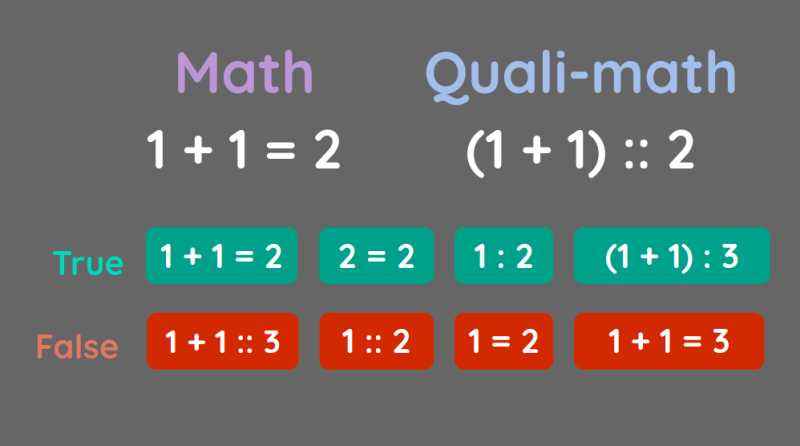Qualimath Decon Notation: Solving the Measurement Problem
Table of Contents
The root cause in the limitations in Physics (and consequently, in the technologies that humans can develop) is the seeming limited ability of humans to perceive beyond the Fire Element (electromagnetism and light).
Beyond the Fire Element is the Air (Space and Time) and the Aether Elements (Idea).
- These 2 Elements are totally subjective and dynamic.
For example:
- The distance from House A to House B can be denoted in meters, yards, feet, etc.
- An idea can be important to some, but not important to others.
We say that such measurements are subjective and heterogenous. Thus, they are more qualitative instead of quantitative or homogenous.
Hence, tanmátras [quantum-perceptions] are the waves produced by the objects as a result of reflection of the subtler bhúta [element or factor] on the cruder ones. Quantum-perceptions in the mathematical sense are heterogeneous, not homogeneous
PR Sarkar
Idea and Ideology, Chapter 3
We can say that:
- The Fire and Earth Elements, as electromagnetism and atoms (strong force) focus on quantitative particles, and make up the Physical Domain
- The Air and Aether Elements, as spacetime and ideas focus on qualitative waves, and make up the Metaphysical Domain
The smallest measuring tool:
- for the physical domain is the electron
- for the metaphysical domain is idea
Therefore, idea solves the measurement problem.
Qualimath
An idea is qualitative, not quantitive.
For example, the idea of demoracy has similar qualities to the idea of liberalism and the opposite qualities of tyranny.
The idea of demoracy is closer to the idea of economy than the idea of a potato. There is no way to quantify the difference between democracy and potato, or democracy as a system of government versus democracy as freedom.
We thus assign qualities to our deconstructed equations.
For example, in Wave 1 + Wave 2 = Wave 3, we assign qualities instead of numbers and processes so we can arrive at the general outcome faster.
The + and = represent the natural actions of the human mind. The minds of less advanced species, such as penguins, might be capable of + and -, but are not capable of * or /.
Likewise, human minds seem to be limited to = and do not dwell so much on : which reqresents the hidden connection between things.*
Superphysics Note
This solves measurement problems by allowing anyone to create a subjective measure. For example, assuming a predefined intuitive range of qualitative* values which focus on looks:
abominable, hideous, very ugly, ugly, unattractive, soso, pretty, beautiful, very beautiful, gorgeous, drop-dead gorgeous
*Qualities are subjective
Then we can create equations:
pretty + pretty = beautiful
beautiful + 2(ugly) = ugly
hideous + beautiful = ugly
This can then be “translated” into any language*:
maganda + maganda = sobrang ganda
kaakit-akit + kadiri = napaka-pangit
dep + dep = rat dep
Superphysics Note
A sample implementation is our use of male and female charges for particles instead of the “positive and negative” used by Benjamin Franklin. In theory, this would lead to new chemical compounds that are unthinkable in Physics, since it is more intuitive to combine different kinds of males with different kinds of females.
This quali-math will make the most sense when you think of a spaceship using quantum teleportation that not only will use 2D space as in a car on Earth or a 3D space like an aircraft, but a space with 4 or 5 dimensions as time-multiverses and alternative universes, where normal math breaks down.
For example, 1 + 1 = 2 might be true for this universe, but it might not be true for a different universe where 1 + 1 = 1 or where the conception of two ideas automatically merges them into one idea. In such a universe, it is the mind that splits itself into different perception-units in order to create the idea of numbers. This is the opposite in our universe, where the perceiving entity is one, and the it is the observed entities that are multiples and discrete.
The Double Colon as Mirror
To account for this mind-splitting behavior, we propose a new notation using flexible colons instead of the rigid equals sign. The former represents the flexible nature of the universe as opposed to its strict rigidity as the latter.

- The single colon is like a flexible ratio. You can think of this as a hazy mirror that lets the other side look a bit different
- The double colon is like a rigid equals sign. This is a clearer mirror but still not a perfect reflection.
- The triple colon is a strict equality that involves the kinds of data*. This is a perfect mirror.